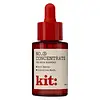What's inside
What's inside
 Key Ingredients
Key Ingredients

 Benefits
Benefits

 Ingredients Side-by-side
Ingredients Side-by-side

Water
Skin ConditioningGlycerin
HumectantButylene Glycol
HumectantCaprylic/Capric Triglyceride
MaskingUndecane
EmollientBakuchiol
AntimicrobialAloe Barbadensis Leaf Extract
EmollientWithania Somnifera Root Extract
Skin ConditioningVaccinium Corymbosum Fruit Extract
Skin ConditioningTasmannia Lanceolata Leaf Extract
Skin ConditioningFucus Vesiculosus Extract
EmollientPropanediol
Solvent1,2-Hexanediol
Skin ConditioningCetearyl Olivate
Tridecane
PerfumingHydroxyacetophenone
AntioxidantSorbitan Olivate
EmulsifyingPolyacrylate Crosspolymer-6
Emulsion StabilisingSodium Benzoate
MaskingPentylene Glycol
Skin ConditioningTocopherol
AntioxidantCaprylyl Glycol
EmollientPotassium Sorbate
PreservativeWater, Glycerin, Butylene Glycol, Caprylic/Capric Triglyceride, Undecane, Bakuchiol, Aloe Barbadensis Leaf Extract, Withania Somnifera Root Extract, Vaccinium Corymbosum Fruit Extract, Tasmannia Lanceolata Leaf Extract, Fucus Vesiculosus Extract, Propanediol, 1,2-Hexanediol, Cetearyl Olivate, Tridecane, Hydroxyacetophenone, Sorbitan Olivate, Polyacrylate Crosspolymer-6, Sodium Benzoate, Pentylene Glycol, Tocopherol, Caprylyl Glycol, Potassium Sorbate
Ingredients Explained
These ingredients are found in both products.
Ingredients higher up in an ingredient list are typically present in a larger amount.
1,2-Hexanediol is a synthetic liquid and another multi-functional powerhouse.
It is a:
- Humectant, drawing moisture into the skin
- Emollient, helping to soften skin
- Solvent, dispersing and stabilizing formulas
- Preservative booster, enhancing the antimicrobial activity of other preservatives
Butylene Glycol (or BG) is used within cosmetic products for a few different reasons:
Overall, Butylene Glycol is a safe and well-rounded ingredient that works well with other ingredients.
Though this ingredient works well with most skin types, some people with sensitive skin may experience a reaction such as allergic rashes, closed comedones, or itchiness.
Learn more about Butylene GlycolHydroxyacetophenone is antioxidant with skin conditioning and soothing properties. It also boosts the efficiency of preservatives.
This ingredient is not irritating or sensitizing.
Potassium Sorbate is a preservative used to prevent yeast and mold in products. It is commonly found in both cosmetic and food products.
This ingredient comes from potassium salt derived from sorbic acid. Sorbic acid is a natural antibiotic and effective against fungus.
Both potassium sorbate and sorbic acid can be found in baked goods, cheeses, dried meats, dried fruit, ice cream, pickles, wine, yogurt, and more.
You'll often find this ingredient used with other preservatives.
Learn more about Potassium SorbatePropanediol is an all-star ingredient. It softens, hydrates, and smooths the skin.
It’s often used to:
Propanediol is not likely to cause sensitivity and considered safe to use. It is derived from corn or petroleum with a clear color and no scent.
Learn more about PropanediolSodium Benzoate is a preservative. It's used in both cosmetic and food products to inhibit the growth of mold and bacteria. It is typically produced synthetically.
Both the US FDA and EU Health Committee have approved the use of sodium benzoate. In the US, levels of 0.1% (of the total product) are allowed.
Sodium benzoate works as a preservative by inhibiting the growth of bacteria inside of cells. It prevents the cell from fermenting a type of sugar using an enzyme called phosphofructokinase.
It is the salt of benzoic acid. Foods containing sodium benzoate include soda, salad dressings, condiments, fruit juices, wines, and snack foods.
Studies for using ascorbic acid and sodium benzoate in cosmetics are lacking, especially in skincare routines with multiple steps.
We always recommend speaking with a professional, such as a dermatologist, if you have any concerns.
Learn more about Sodium BenzoateWater. It's the most common cosmetic ingredient of all. You'll usually see it at the top of ingredient lists, meaning that it makes up the largest part of the product.
So why is it so popular? Water most often acts as a solvent - this means that it helps dissolve other ingredients into the formulation.
You'll also recognize water as that liquid we all need to stay alive. If you see this, drink a glass of water. Stay hydrated!
Learn more about Water